As a new surfer, it is important to know how to choose a beginner surf spot. Many surf spots are not suitable for beginners and can be dangerous.
In addition, even beginner friendly surf spots may not be suitable depending on the conditions for a given day. Lots of surf spots are suitable for beginners on some days but not others.
If you are a new surfer, keep reading to learn how to choose a beginner surf spot that will be fun and safe for your skill level.
What surf spots are good for beginners?
A good beginner surf spot is one that is mellow, forgiving, and well known. Look for surf spots with the following characteristics.
1. Long ride time
A wave is rideable from when it first breaks (or even before it breaks) to when it is too small to ride. The ride time can include when the wave is unbroken, breaking, or after it is closed out.
You want the ride time to be as long as possible, to give you the most time to catch the wave, stand up, and practice balance and turns. Ideally, look for waves that have a ride time of about 10 seconds (around 10 meters). The more ride time the better.

Different surf spots will have different types of waves. Some beaches or reefs are steeper than others. As the ocean floor steepens, the wave breaks faster, and the potential ride time is reduced. The tide may affect how the wave breaks at certain surf spots.
2. Limited safety risks
A good surf spot for beginners will not have any extreme rip currents or obstacles like rocks or jetties. In general, beach breaks are best for beginners. Some reef breaks are good for beginners, but during low tides the reef or rocks can pose a hazard.
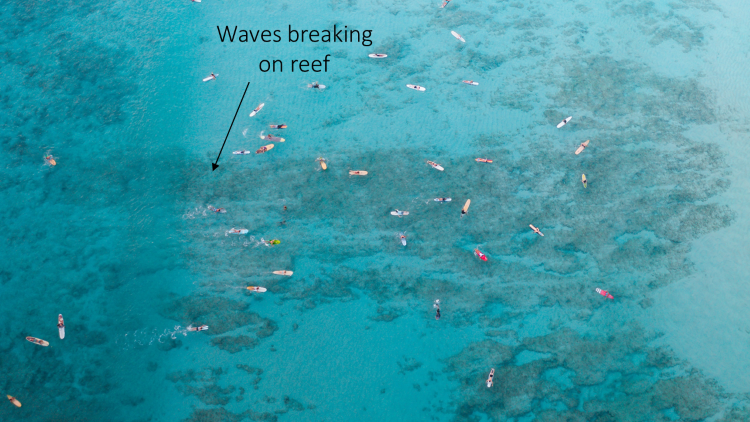
Also, it should be easy to enter and exit the surf spot. You should be able to walk your board out into the water on sand, and not have to enter or exit via rocks.
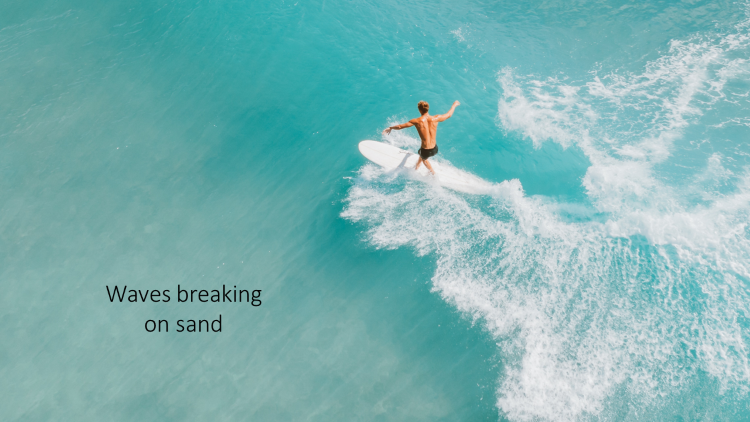
Ideally, you should be able to surf at a beginner surf spot during all tides, without risk of danger arising from a changing tide. Learn more about how to surf safely and avoid dangers.
3. Well known beginner surf spot
A good beginner surf spot is well known. As a beginner you want to know that the spot you are surfing at is an established surfing beach. If you don’t see other surfers there, don’t go out.

There are many surf spots that are generally known as being suitable, even recommended, for learning how to surf. Try to choose one of these spots in your location.
How to find a beginner surf spot near you
If you are a new surfer, you may be wondering how to find a surf spot that has a long ride time, limits safety risks, and is well known. There may be many surf spots near you or just a few. Either way, use the following methods to find beginner surf spots.
1. Contact local surf shops
Local surf shops are a great resource for all things surfing. However, they are particularly valuable when finding information on local or regional surf spots.
Don’t hesitate to visit a surf shop in person or call and ask the employees questions about local surf spots. Ask them about ride time, safety risks, and popularity. Also ask if the spot changes with the tide.
You can also ask about surf lessons. Surf lessons will only occur in beginner friendly surf spots, so you can ask which beaches they offer lessons at. I always recommend beginner surfers take a lesson.
2. Talk to other surfers
Perhaps similar to contacting local surf shops, local surfers will also have some valuable information. Most surfers are friendly to beginners and will give their honest opinion on the best surf spots for learning. You might be interested in learning how to find people to surf with.
3. Go see surf spots in person
If you are close to one or more surf spots, you can go see them in person. If you do visit some, or if you are there to surf, check out the ride time, safety risks, and popularity.

How many people are out? Can you see any rips or rocks? How deep is the water? Is the ocean floor sand or reef? Can you measure the ride time?
I recommend visiting the same surf spots multiple times, ideally during different conditions. That way, you will become more familiar with how the waves behave at your local spots.
4. Use a surf forecast website
A surf forecast website will help you find surf spots near you. Usually, they will have a somewhat generic description of the spot with a scale for how suitable the spot is for beginners.
Use this with caution, as the conditions on any given day will determine heavily if it is appropriate for beginners. It is important to know how to read a surf forecast. Also, check out the best surf forecast websites.
How to use a surf forecast
A surf forecast is a critical tool that all surfers should know how to use. There are several main surf forecast websites that will predict conditions for local surf spots near you.
A surf forecast will predict conditions such as swell height, swell direction, wind speed and direction, period, water temperature, as well as tide times and heights.
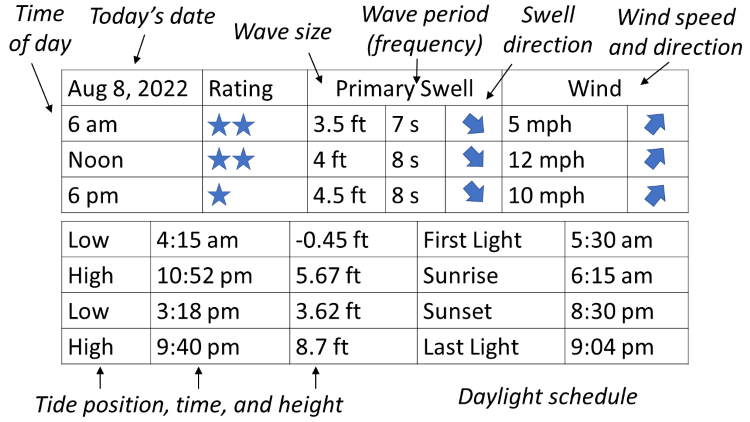
If you are not familiar with a surf forecast, learn more about how to read a surf forecast.
What surf conditions are best for beginners?
A surfing spot that is suitable for beginners may not always have the best conditions for learning. The waves may be too powerful or the wind too strong.
The general idea is to look for waves that are not too big, a period that is sufficiently long, and low wind. These conditions combined with a surfing spot suitable for beginners is a recipe for a fun day of learning how to surf!
The table below shows the range of surf conditions suitable for beginner surfers.
| Not Great | Getting Better | Best | |
|---|---|---|---|
| Wave Size (Feet, Meters) | < 1 ft, > 5 ft < 0.3 m, > 1.5 m | 1 – 4 ft 0.3 – 1. 2 m | 2 – 3 ft 0.6m – 0.9m |
| Period (Seconds) | < 7 s | 7 – 10 s | > 10s |
| Wind (mph, m/s) | > 15 mph > 6.7 m/s | 8 – 14 mph 3.6 – 6.3 m/s | < 8 mph < 3.6 m/s |
| Swell Direction | Depends on location | ||
| Tide | Depends on location |
What wave size is for beginner surfers?
Waves 2-3 feet high are best for beginner surfers. Anything smaller than 2 feet may not have enough power, even if you are using a larger board. Anything larger than 4 feet is probably too large. However, it does depend on the type of wave. A fast, steep, hollow wave that is 3 feet tall can have more power than a slow, mushy wave that is 4 feet tall.
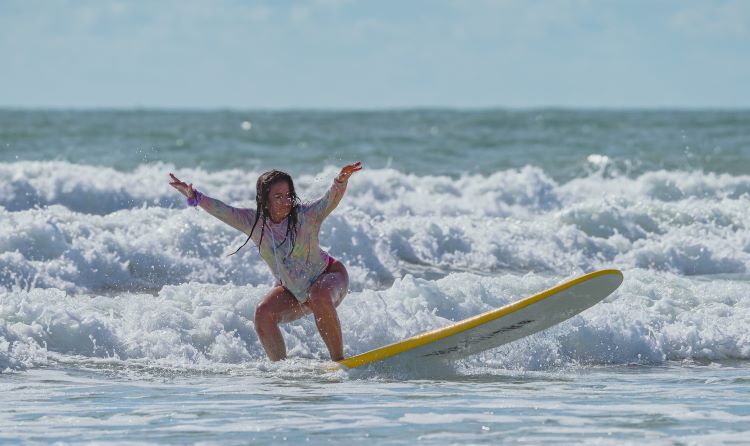
What period is best for beginner surfers?
Beginner surfers should look for a period larger than 7 seconds. Anything less than 7 seconds will probably result in poor waves that are too close together. That said, you can still have fun and practice in the whitewater.
Also be aware, the larger the period the more powerful the waves. For example, waves during a 14 second period will be more powerful than waves during a 7 second period.
What wind speed is best for beginner surfers?
Ideally, surf when wind speed is less than 8 miles per hour. You can definitely still surf in winds up the 15 miles per hour, but anything above that is questionable. Note that certain surf spots may be more protected and have better conditions based on the wind direction.
How to choose a beginner surf spot for kids
Yes! Surfing can be safe for kids. Choosing a beginner surf spot for kids is more or less the same as adults. The main idea is to make sure the conditions are extra mellow and relaxed.
Kids and teenagers have a harder time managing a surfboard and navigating the waves. They generally don’t have the same muscle power as adults.
Again, talk to your local surf shop for guidance. Kids can and should surf, and it is not as intimidating as it may seem. You just need a little extra knowledge as their guardian, and therefore need to pay extra close attention to the surf spot and conditions.
If you’re learning how to surf with your kid, check out my full guide to choosing a beginner surfboard and also learn about how to choose a surfboard for kids. I also recommend you take a surf lesson.
Other things to consider when learning how to surf
Learning how to surf can be tough. Learning during the right conditions will definitely make it easier and more fun. However, you should also be using the correct surfboard. Learn more about how to choose a beginner surfboard. I recommend beginners start on a longboard. True beginners should start on a soft-top longboard, rather than a hard-top.
Once you learn the basics of surfing using a soft-top, then you can progress to a hard-top surfboard. Learn more about if you’re ready to progress to a hard-top.
Conclusion
In conclusion, choose a surf spot that has long ride time (waves break gradually), is well known, and has no major safety hazards (like rocks and rip currents). In addition, read the surf forecast ahead of time and choose a day with waves 2-3 feet high, a period larger than seven seconds, and wind speed less than 8 miles per hour. Most importantly, get out here and have fun!
Heads up! Surfing is awesome but it can be dangerous! Learn more about how to stay safe and avoid dangers while surfing. If you are a beginner surfer, check out my other articles about surfing and my ultimate guide to learning how to surf.

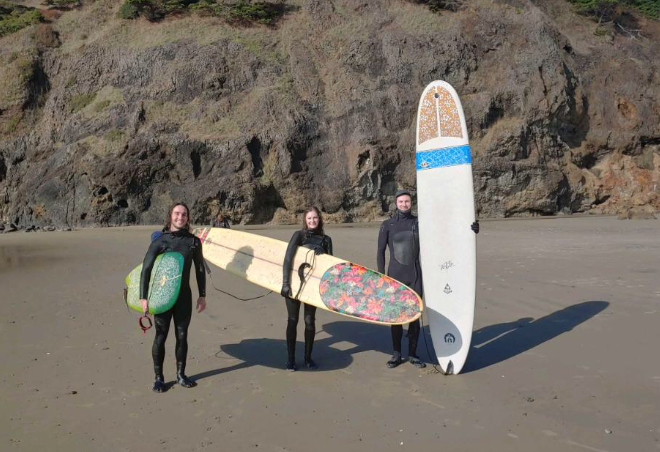
![Best longboard surfboards [2023] – all skill levels surfer with surf hat](https://mindfulladventure.com/wp-content/uploads/2022/10/surf-hat-crop-1000-270x180.jpeg)




